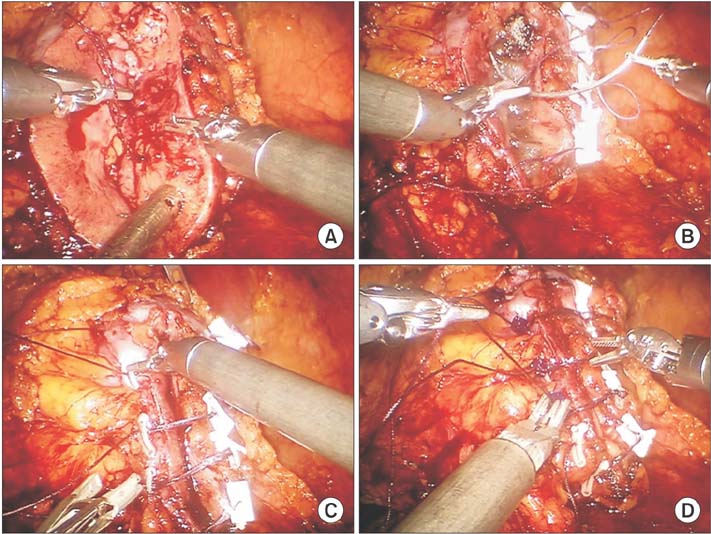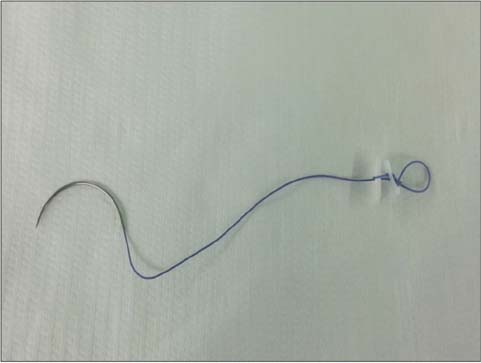Korean J Urol.
2015 Nov;56(11):762-768. 10.4111/kju.2015.56.11.762.
The clinical application of the sliding loop technique for renorrhaphy during robot-assisted laparoscopic partial nephrectomy: Surgical technique and outcomes
- Affiliations
-
- 1Department of Urology, Seoul National University College of Medicine, Seoul, Korea. drboss@korea.com
- KMID: 2351039
- DOI: http://doi.org/10.4111/kju.2015.56.11.762
Abstract
- PURPOSE
To report the initial clinical outcomes of the newly devised sliding loop technique (SLT) used for renorrhaphy in patients who underwent robot-assisted laparoscopic partial nephrectomy (RALPN) for small renal mass.
MATERIALS AND METHODS
We reviewed the surgical videos and medical charts of 31 patients who had undergone RALPN with the SLT renorrhaphy performed by two surgeons (CWJ and CK) between January 2014 and October 2014. SLT renorrhaphy was performed after tumor excision and renal parenchymal defect repair. Assessed outcomes included renorrhaphy time (RT), warm ischemic time, perioperative complications, and perioperative renal function change. RT was defined as interval from the end of bed suture to the renal artery declamping.
RESULTS
In all patients, sliding loop renorrhaphy was successfully conducted without conversions to radical nephrectomy or open approaches. Mean renorrhaphy and warm ischemic time were 9.0 and 22.6 minutes, respectively. After completing renorrhaphy, there were no adverse events such as dehiscence of approximated renal parenchyma, renal parenchymal tearing, or significant bleeding. Furthermore, no postoperative complications or significant renal function decline were observed as of the last follow-up for all patients. The limitations of this study include the small volume case series, the retrospective nature of the study, and the heterogeneity of surgeons.
CONCLUSIONS
From our initial clinical experience, SLT may be an efficient and safe renorrhaphy method in real clinical practice. Further large scale, prospective, long-term follow-up, and direct comparative studies with other techniques are required to confirm the clinical applicability of SLT.
Keyword
MeSH Terms
Figure
Reference
-
1. Campbell SC, Novick AC, Belldegrun A, Blute ML, Chow GK, Derweesh IH, et al. Guideline for management of the clinical T1 renal mass. J Urol. 2009; 182:1271–1279.2. Touijer K, Jacqmin D, Kavoussi LR, Montorsi F, Patard JJ, Rogers CG, et al. The expanding role of partial nephrectomy: a critical analysis of indications, results, and complications. Eur Urol. 2010; 57:214–222.3. Gill IS, Kavoussi LR, Lane BR, Blute ML, Babineau D, Colombo JR Jr, et al. Comparison of 1,800 laparoscopic and open partial nephrectomies for single renal tumors. J Urol. 2007; 178:41–46.4. Singh I. Robot-assisted laparoscopic partial nephrectomy: current review of the technique and literature. J Minim Access Surg. 2009; 5:87–92.5. Bhayani S, Figenshau R. The Washington university renorrhaphy for robotic partial nephrectomy: a detailed description of the technique displayed at the 2008 World Robotic Urologic Symposium. J Robot Surg. 2008; 2:139–140.6. Benway BM, Wang AJ, Cabello JM, Bhayani SB. Robotic partial nephrectomy with sliding-clip renorrhaphy: technique and outcomes. Eur Urol. 2009; 55:592–599.7. Benway BM, Cabello JM, Figenshau RS, Bhayani SB. Sliding-clip renorrhaphy provides superior closing tension during robot-assisted partial nephrectomy. J Endourol. 2010; 24:605–608.8. Sammon J, Petros F, Sukumar S, Bhandari A, Kaul S, Menon M, et al. Barbed suture for renorrhaphy during robot-assisted partial nephrectomy. J Endourol. 2011; 25:529–533.9. Hillyer S, Spana G, White MA, Autorino R, Laydner H, Khanna R, et al. Novel robotic renorrhaphy technique for hilar tumours: 'V' hilar suture (VHS). BJU Int. 2012; 109:1572–1577.10. Olweny EO, Park SK, Seideman CA, Best SL, Cadeddu JA. Selfretaining barbed suture for parenchymal repair during laparoscopic partial nephrectomy; initial clinical experience. BJU Int. 2012; 109:906–909.11. Jeon SH, Jung S, Son HS, Kimm SY, Chung BI. The unidirectional barbed suture for renorrhaphy during laparoscopic partial nephrectomy: Stanford experience. J Laparoendosc Adv Surg Tech A. 2013; 23:521–525.12. Wahafu W, Ma X, Li HZ, Ding Q, Wang BJ, Shi TP, et al. Evolving renorrhaphy technique for retroperitoneal laparoscopic partial nephrectomy: single-surgeon series. Int J Urol. 2014; 21:865–873.13. Lee JK, Oh JJ, Lee S, Lee SB, Byun SS, Lee SE, et al. A new sliding-loop technique in renorrhaphy for partial nephrectomy: a feasibility study in a porcine model. Surg Innov. 2015; 07. 12. [Epub]. DOI: 10.1177/1553350615595321.14. Uzzo RG, Novick AC. Nephron sparing surgery for renal tumors: indications, techniques and outcomes. J Urol. 2001; 166:6–18.15. McDougall EM, Clayman RV, Chandhoke PS, Kerbl K, Stone AM, Wick MR, et al. Laparoscopic partial nephrectomy in the pig model. J Urol. 1993; 149:1633–1636.16. Winfield HN, Donovan JF, Godet AS, Clayman RV. Laparoscopic partial nephrectomy: initial case report for benign disease. J Endourol. 1993; 7:521–526.17. Gettman MT, Blute ML, Chow GK, Neururer R, Bartsch G, Peschel R. Robotic-assisted laparoscopic partial nephrectomy: technique and initial clinical experience with DaVinci robotic system. Urology. 2004; 64:914–918.18. Beasley KA, Al Omar M, Shaikh A, Bochinski D, Khakhar A, Izawa JI, et al. Laparoscopic versus open partial nephrectomy. Urology. 2004; 64:458–461.19. Porpiglia F, Volpe A, Billia M, Scarpa RM. Laparoscopic versus open partial nephrectomy: analysis of the current literature. Eur Urol. 2008; 53:732–742.20. Gettman MT, Blute ML, Peschel R, Bartsch G. Current status of robotics in urologic laparoscopy. Eur Urol. 2003; 43:106–112.21. Mullins JK, Feng T, Pierorazio PM, Patel HD, Hyams ES, Allaf ME. Comparative analysis of minimally invasive partial nephrectomy techniques in the treatment of localized renal tumors. Urology. 2012; 80:316–321.22. Zhang X, Shen Z, Zhong S, Zhu Z, Wang X, Xu T. Comparison of peri-operative outcomes of robot-assisted vs laparoscopic partial nephrectomy: a meta-analysis. BJU Int. 2013; 112:1133–1142.23. Kim TS, Oh JH, Rhew HY. "Off-clamp, non-renorrhaphy" laparoscopic partial nephrectomy with perirenal fat and Gerota's fascia reapproximation: initial experience and perioperative outcomes. J Laparoendosc Adv Surg Tech A. 2014; 24:339–344.24. Ramanathan R, Leveillee RJ. A review of methods for hemostasis and renorrhaphy after laparoscopic and robot-assisted laparoscopic partial nephrectomy. Curr Urol Rep. 2010; 11:208–220.25. Khalifeh A, Autorino R, Hillyer SP, Kaouk JH. V-hilar suture renorrhaphy during robotic partial nephrectomy for renal hilar tumors: preliminary outcomes of a novel surgical technique. Urology. 2012; 80:466–471.26. Orvieto MA, Chien GW, Tolhurst SR, Rapp DE, Steinberg GD, Mikhail AA, et al. Simplifying laparoscopic partial nephrectomy: technical considerations for reproducible outcomes. Urology. 2005; 66:976–980.
- Full Text Links
- Actions
-
Cited
- CITED
-
- Close
- Share
- Similar articles
-
- Robotic Radical Nephrectomy with Vena Caval Tumor Thrombectomy: Experience of Novice Robotic Surgeons
- Feasibility of Laparoendoscopic Single-Site Partial Nephrectomy in a Porcine Model
- How far has robot-assisted partial nephrectomy reached?
- A Feasible Technique for Transient Vascular Occlusion by Using a Vessel Loop and Hem-o-Lok Clips in Laparoscopic Partial Nephrectomy
- Robot-assisted Laparoscopic Partial Nephrectomy




